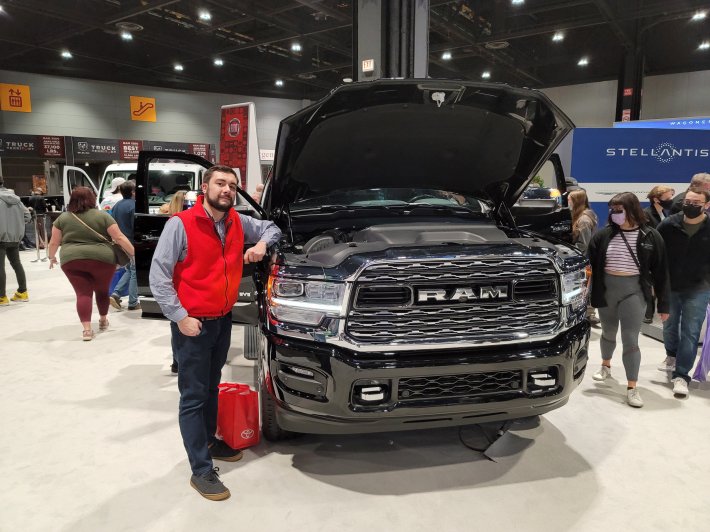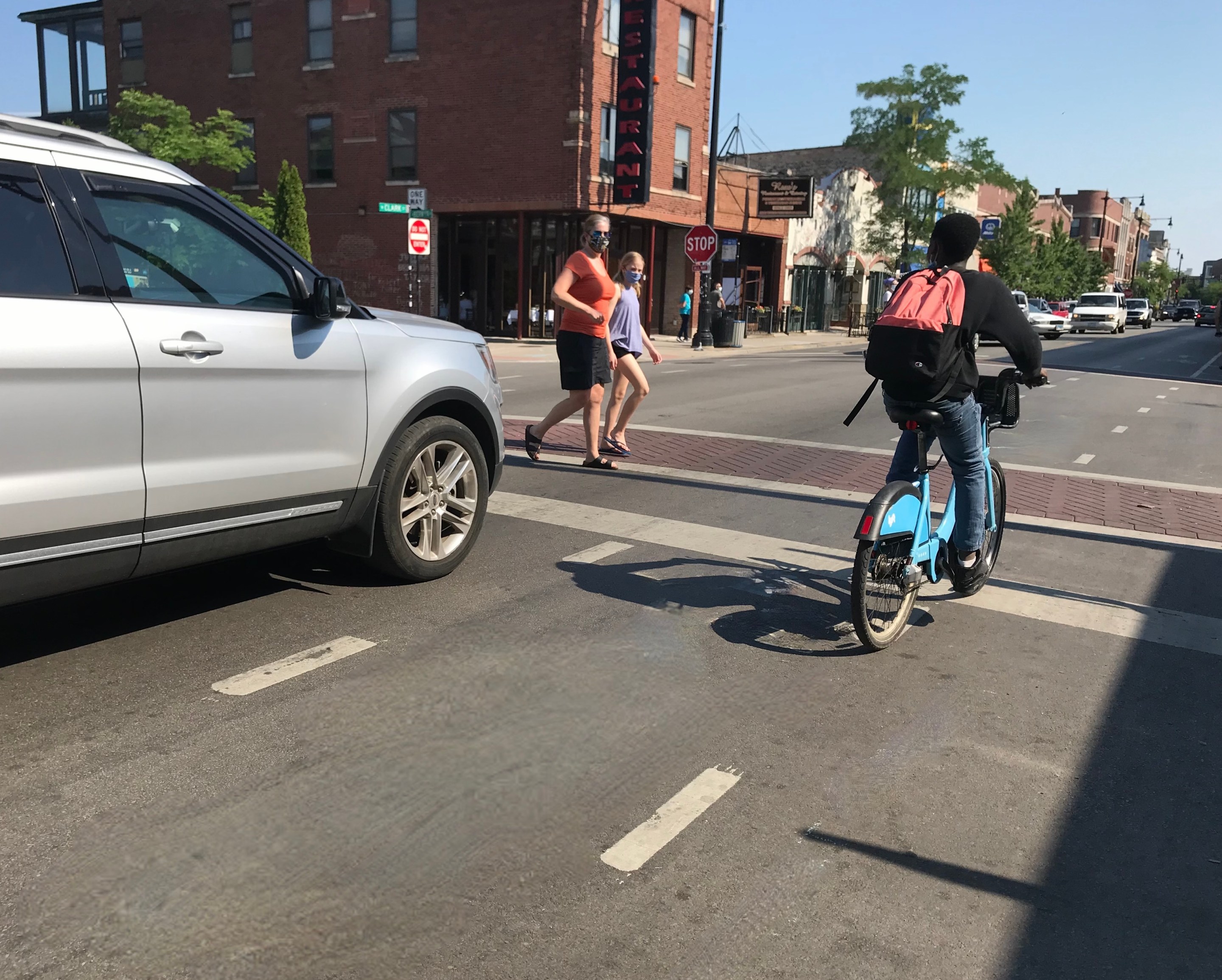Update 6/10/22, 11:00 AM: By Wednesday evening, more than 15,000 Americans, including transportation experts, safety officials, parents, consumer advocates, and the Chicago Department of Transportation, had asked the Biden Administration to update the "outdated" ratings system that gives misleadingly high safety ratings to the vehicles most likely to kill pedestrians and cyclists, according to the National Association of City Transportation Officials.
Americans like to super-size. Big Macs, big TVs, and big cars.
Over the last two decades, the popularity of SUVs, pickup trucks, and vans has exploded, overtaking sedans and compacts. The “light truck” category, which includes all these vehicles, grew from just over half of new sales and leases in 2010 to 76 percent in 2020, according to the Bureau of Transportation Statistics.
The market was reflected in this year’s Super Bowl broadcast, which had ads with people driving gleaming pickups through empty landscapes, ready to pull someone out of an avalanche or haul some hay. In real life, you’re more likely to see them in a supermarket parking lot, transporting a single passenger with groceries.
The big cars are also getting bigger – the largest vehicles on the market now weigh around 7,000 pounds.
What’s the attraction, for those who don’t actually need such a behemoth for their business, or to carry a large family?
“It gives you a feeling of power, of being higher up than other people on the road,” said Alex Perez, advocacy manager for the Active Transportation Alliance.
You’re also safer, if you’re an occupant. In 2016, the highest occupant fatality rate per 100,000 registered vehicles was for compact cars at 12.91 fatalities, while standard pickup trucks were at 8.86, and full-size SUVs were at 6.78, according to the National Highway Traffic Safety Administration.

But while big vehicles are safer for people on the inside, they're more deadly for those on the outside. Pedestrian fatalities shot up 54 percent between 2010 and 2020, compared to 13 percent for all other traffic deaths, according to a Governors Highway Safety Association’s report in May. During that time, the percentage of fatal crashes involving SUV drivers grew faster than the percentage of deadly collisions involving cars drivers, the same report found.
“Larger vehicles are inherently more dangerous to pedestrians,” the GHSA report noted. This is simple physics – the bigger and heavier something is, the harder it’s going to hit.
The design of some larger vehicles also may create blind spots for drivers. The Insurance Institute for Highway Safety found that drivers of SUVs, pickups, vans, and minivans are “substantially more likely” than car drivers to hit pedestrians when making turns, suggesting that these larger vehicles may not afford drivers as clear a view of people crossing the road.
“We already know that larger vehicles cause more severe injuries when they strike pedestrians,” said IIHS Vice President of Research Jessica Cicchino, one of the study’s authors. “The link between these vehicle types and certain common pedestrian crashes points to another way that the increase in SUVs on the roads might be changing the crash picture.”
“They are larger, heavier and higher up from the road than smaller cars and create blind spots that make it challenging for drivers to see vulnerable road users like pedestrians and cyclists,” Perez said. Vehicles have also gotten wider, making it scarier for bike riders protected by nothing more than paint or plastic bollards, Perez noted.

Fortunately for vulnerable road users and the climate, the momentum for oversized private vehicles may be slowing.
One factor is higher gas prices. As hard as they've been on lower-income drivers and those who have to drive for a living, paying close to $6 a gallon for gas has a silver lining in that it’s influencing car buyers to go smaller. According to Cox Automotive, which analyzes sales information from Kelley Blue Book and Auto Trader, electric vehicles and hybrids have gotten very popular since January. But so is shopping for more fuel-efficient gas-powered models, like small and midsize cars, which is up 33 percent.
City governments also have started to put pressure on the industry. The National Association of City Transportation Officials, a coalition of city transportation departments and transit agencies across the U.S. and Canada, is urging its members to help change how the U.S. Department of Transportation rates car safety to show the negative impact of big vehicles.
Currently, under the federal government’s New Car Assessment Program, nearly every vehicle gets four or five-star ratings. These ratings, ballyhooed on car commercials, only take into account the safety of humans inside cars, not outside them, NACTO explains. New rules proposed by the USDOT would begin rating cars based on their safety impacts for pedestrians. NACTO believes the proposed changes don’t go far enough, and wants the USDOT to only reward a five-star rating to vehicles with certain safety features, such as direct visibility from the driver’s seat and systems that automatically limit unsafe speeds.
Comments on the rule changes are due by June 8. A Chicago Department of Transportation spokesperson confirmed that the agency, which is a NACTO member, sent a letter this week supporting the campaign.
The CTA is also a member, but it was not immediately known whether the transit agency would add its voices to the campaign.
“We have to acknowledge the actual safety of our vehicles, not giving them five stars when they’re more likely to get into a crash and kill someone in a crash,” said NACTO spokesman Alex Engel. He said that admitting that some of these vehicles are not safe “could nudge manufacturers to redesign their vehicles for more safety, and show consumers these vehicles are not safe and they’re being misled.”
Kate Lowe, associate professor in urban planning and policy at the University of Illinois Chicago, said that other countries are taking the lead in adopting vehicle safety regulations that protect road users outside vehicles, like bicyclists and pedestrians, and the U.S. needs to catch up. “The increasing number of large vehicles, like SUVs, coupled with a roadway system designed for speed, are deadly for pedestrians, bicyclists and others outside the vehicles,” Lowe said.
Audrey Wennink, transportation director for the Metropolitan Planning Council, agreed that our country needs to reexamine what it calls a “safe” vehicle. “The U.S. must start conducting tests of pedestrian safety outside vehicles, as has been done in Europe,” Wennink said. “Given the sharp increase in pedestrian deaths and injuries from vehicle crashes, and the trends towards bigger SUVs and pick-up trucks, we need to more to address this issue.”
Taking a stand on this problem is the city of Washington, D.C., which has proposed requiring owners of vehicles weighing over 6,000 pounds, such as a Ford F-250 or a Chevy Silverado HD, to pay an annual $500 registration fee, almost seven times the cost to register a sedan. No other U.S. jurisdiction has created such a disincentive against the biggest car models, according to Bloomberg News. For comparison, Chicago’s sticker fee for passenger vehicles that weigh more than 4,500 pounds is $151.55, only about $56 more than the $95.42 fee for smaller vehicles.
Engel sees the news out of D.C. as encouraging. “Our entire network is going to be looking to see how well this works in D.C. and whether this is enough of a nudge,” Engel said. “We can see what we can do to nudge people towards safer options.”





